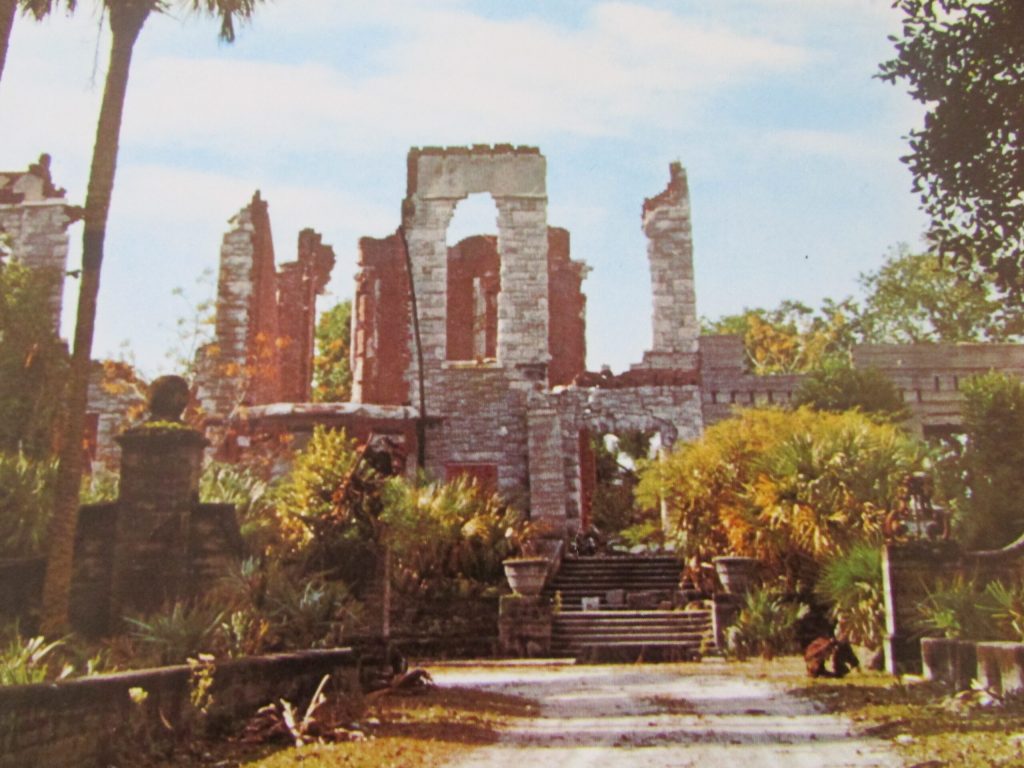Built on a Curse-Part 2
Published 12:45 pm Sunday, August 11, 2024
|
Getting your Trinity Audio player ready...
|
Previously, we learned about the very early history of Cumberland Island, from the prehistoric Indians to the Spanish and English settlers there. We also studied the woman who was responsible for the first huge mansion called Dungeness and how the curse manifested itself there. Take my hand and we will go to the garden where we can pick up where we left off.
In 1812, America was once again at war with Britain. The residents of Cumberland Island were warned to leave but Caty Greene Miller would not budge. She had her own war going on which involved two of her three remaining children, Cornelia and Martha. All of the bad feelings were because of the land that their father, General Nathanael Greene owned in Tennessee. It seems that Caty did not know about these acres and wanted to get her hands on them. The daughters each wanted their share but Caty wanted it all. Everything got worse when her two son-in-law’s plotted against her. In the end, Cornelia and her husband, Ned, along with their children were put in jail in Savannah for several days. Caty got the land when several old friends in Savannah signed a note to purchase the land from Caty. Her birthright taken away, Cornelia, Ned and the children left Georgia and never returned. Cornelia became a talented, moderately known, writer.
Martha and Caty now argued over who would own the rights to the priceless metals on the land and the contents of Greene’s valuable library. When Nathanael wrote his will, he left the then five children each a parcel of land on Cumberland Island. As two of the children had died, Caty inherited their shares. With all of the fighting going on and Caty was not getting what she wanted, she disinherited both Cornelia and Martha leaving Dungeness, the only property that was left in the family, to the youngest child, Louisa. Still Caty did not have any peace. She was still deeply in debt and there were lawsuits against Nathanael and Phineas that she had inherited.
Trending
When the War of 1812 ended, Admiral Cockburn of the British Navy did not know this. He stomped ashore at the north end of the island and he and his men made their way to Dungeness. Once there, they took it over and only allowed the family to live on the top floor. This lasted a month and then Cockburn and the Miller family knew the war was over and that America had won her freedom, again. The British couldn’t leave fast enough for they did not like the heat, humidity and snakes.
One happy event did take place at Dungeness. That was in 1814, when Louisa married James Shaw. However, in late August, the curse seemed to catch up to Caty, who caught a fever that quickly worsened. She suffered violet chills and could not eat and became very thin. By September 2, 1814, she was dead. She was buried in the little tabby walled cemetery next to Phineas, near a tidal creek.
It was now up to Louisa and James to take care of the many acres they now owned on Cumberland Island, including Dungeness. As it ended up, Louisa was the only Greene to live full time in the mansion. Once settled, Louisa then invited her sister, Martha, to a small gathering and asked her and her family to move into the lavish home.
Then, early in February, 1818, a feeble, old man was carried ashore from a schooner which came to the Dungeness dock. General Henry “Light-Horse Harry” Lee, now 62, was a Revolutionary War hero and had fought valiantly beside General Greene. They were more than fighting companions, they were close friends.
Lee had become very ill after being stabbed during an argument. Remembering his old friend, Lee asked the ship’s captain to put him ashore on Cumberland Island. He felt that being on land would bring his health back. After hearing that his old friend had passed on, he asked for help from Louisa. Willingly, she did what she could to make him as comfortable as possible. However, the change didn’t help and he withered away. After two months, he died from what was thought to be cancer. Lee was buried in the tabby walled cemetery with Catherine and Phineas. His grave was visited several times by his famous son, Confederate General Robert E. Lee. Later in time, General Henry Lee’s remains were moved to be next to his son, on the campus of Lee and Washington University in Lexington, Virginia.
Unlike her mother, Louisa was not greedy and she was good with finances and Dungeness began to thrive. However, she died unexpectedly in 1831 at the age of 45. She was placed in the family cemetery and her personal belongings were sent to General Greene’s library. Having no children, Louisa left the land to her nieces and nephews. Now the death toll was seven.
Trending
With Dungeness on the south end of the island and the harbors in the north, the middle became the property of Robert Stafford. Born December 8, 1790, he built the Planters’ House. Unfortunately, it burned in 1901. However, at this time the Carnegie’s were living on Cumberland Island and Lucy Carnegie rebuilt the home for the family. It is still in existence. Robert Stafford eventually became the largest landholder on Cumberland. After he died August 1, 1877, and was buried in the small graveyard near the Stafford House, his daughters and their families took over the plantation.
The War Between the States laid waste to the land on Cumberland Island. In 1862, the Confederate warship, CSS Alabama, came to rescue those trapped on Cumberland, when Union forces threatened to over-run it.
When the War was over, in 1866, Dungeness was destroyed by fire. The plantations were abandoned and the forest gradually reclaimed the land. In 1870, folks who formerly worked on the plantation now owned by Stafford, and his sons-in-laws, Nightingale and Downs, moved to the north end of the island. It was called the Brick Kiln Settlement. Some bought 50’ by 100’ lots on which they built houses. Then, they got together and in 1893, built the First African Baptist Church which is still there but padlocked.
Time passed on its uninterruptable journey and on November 17, 1881, former Union General William George Davis, first cousin to Confederate President Jefferson Davis, bought the Dungeness property from Louisa’s heir, Phineas Nightingale, who was married to one of the Stafford daughters. The Dungeness curse just could not rest and it claimed the life of the five-year-old grandson of Davis, when he was accidentally shot by his father, Phineas Nightingale, during a hunting trip. Two months later, the father committed suicide. Add another two to the death toll at Dungeness.
Davis sold his 2000 acres on Cumberland Island in 1882, which included the ruins of Dungeness, to 38-year-old Thomas Carnegie, brother of steel tycoon, Andrew Carnegie. At his wife, Lucy’s, suggestion, Thomas, along with a business partner, Leander Morris, purchased the adjoining 8,500 acres from Robert Stafford’s heirs. Thomas and Lucy now owned over 10,000 acres on Cumberland Island.
Thomas’s interest in this property started with a story he had read in Lippincott Magazine that was about Cumberland Island and Dungeness. Despite the curse, both Thomas and Lucy were very enthralled and decided that they had to own land on this island. The plan was that Thomas and Lucy would build the third Dungeness on the foundation of the second one. To do this, they hired architect Andrew Peoples. The ruins of the old mansion were leveled and construction began with the cornerstone of the new house being set in 1884. Now, the house was going up as were most of the outbuildings.
This Dungeness was the grandest of them all. Larger than the second mansion and for sure more ostentatious than the first. It was 6,720 square feet of living space that consisted of 44 rooms. The tower rose 100 feet in the air and was furnished with soft, comfortable couches. However, most stunning of all was the gorgeous views of the ocean, the salt marsh and the mainland.
The high ceilings, doors, and wainscoting were of highly polished Georgia pine. The floors were parquet but that in the vestibule was made of blocks of blue colored marble bordered in black. On every level, light filtered through stained glass windows casting knife like shards of color on the walls and floors. There was a music gallery, a library, a reading room, a gun room, a huge dining room and a 25 foot by 55-foot hallway. There was a 16-foot-high fireplace where an oak mantel was carved with the family motto: The Hearth Our Altar, It’s Flame Our Sacred Fire. The mansion was completed by January 1, 1885.
The mansion was far ahead of its time because it contained indoor plumbing, a laundry, a mess hall, and a kitchen and living quarters for the employees. On the grounds, Dungeness had 40 outbuildings including a pool house, golf course, a squash court, stables and gardens. Nonetheless, all this could not keep the curse away.
In October, 1886, Thomas came down with a cold while in Pittsburgh, Pennsylvania. On Friday afternoon, he told the clerks in his office he wasn’t feeling well and went home. The next day, he was worse. Lucy was alarmed and called the family physician, Dr. Semple. Dr. Fleming, another physician and friend of the family was also called to give a second opinion. Both men agreed on the diagnosis of pneumonia. Thomas weakened steadily. With Thomas’s health failing, Lucy gathered all of the nine children around the father they adored. On October 19, 1886, only one day before his 40th birthday, Thomas Carnegie died. At the time, the children were: Will, 19; Frank, 18; Andrew, 16; Margaret, 14; Thomas Jr., 12; George, 10; Florence, 7; Coleman, 6; Nancy, 5. Lucy now took over the huge task of raising nine children and taking care of Thomas’s business holdings as well as Dungeness.
There are quite a few similarities in the lives of the Carnegies and the Millers. Sadly, Lucy and Thomas did not get to spend much time together and enjoy Cumberland Island. Nor did Thomas get to see the completely finished mansion. Caty and her second husband, Phineas Miller did not get to spend much time together as Phineas died an untimely death, too. Ironically, both Thomas and Phineas died in their early 40s and left their wives, both strong women, to take care of large families and Dungeness. However, there are historians that believe it was Thomas’s heavy drinking, a crutch that he used to escape the many demands put on him by his brother, Andrew, was really responsible for his early end.
Life went on and the Carnegie family grew in numbers as well as land holdings. Everyone loved Cumberland Island and the large sprawling home. Lucy was somewhat like Caty Miller in that she loved parties and having guests visit. However, she was very good at finances and when she spent large sums of money, it was either on bettering Dungeness or expanding the families’ land holdings on Cumberland Island.
In 1912, Lucy was 66 and wrote her will. In it she provided that all of her land holdings and its buildings be divided amongst the nine children. When one would pass away their children would inherit and in turn, their children would then inherit. Thus, she provided that Cumberland Island and Dungeness remained in the family.
Near the end of 1915, Lucy came down with a head cold and an upper respiratory infection. She had grown very stout and was unhappy about this. Her once dark hair turned snow white and the luster had faded from her dark eyes. Worried because she could not shake this illness, she left Cumberland Island and went to Baltimore, to Johns Hopkins for treatment. When she seemed better, she checked out and went to Waverly, Massachusetts, to live on the Carnegie estate there. She chose this place because her doctor was there and her granddaughter, Retta, had a summer home too. However, Lucy got worse and on a terrible weather day, January 6, 1916, at age 69 she died in her sleep. Pneumonia was listed as the cause. Perhaps it was because the spirits knew that Lucy loved Cumberland Island and that it was her foremost responsibility, she lived what was back then, a long life. Therefore, the curse did not touch her. However, it did rear its ugly head and invade the Carnegie family, if you consider that so many of their deaths were due to alcoholism, a curse.
However, life went on and with all of the children, spouses and grandchildren, Dungeness was occupied all year round. There was always something going on. The mansion was in its glory days around 1910. Dinners were always formal with tuxedos and ball gowns. Food was lavish and served with crystal and gold. Like Caty Miller, in her day, Lucy Carnegie was the world’s most renowned hostess. For five generations, the Carnegie family continued using Dungeness as a retreat.






